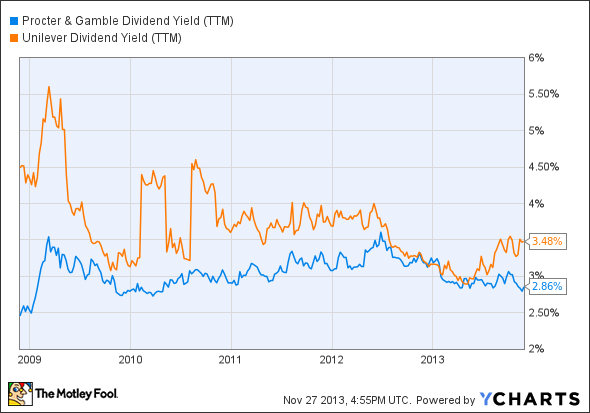Filed under: Investing
Soft-drink leader Coca-Cola has done fairly well for investors during 2013, treating shareholders to a 13% total return so far this year. But given the 23% jump in the Dow Jones Industrials , Coke's performance looks fairly weak. Even worse, rival PepsiCo has climbed even more substantially, with gains of 26% in 2013. That has investors wondering why Coca-Cola has lagged behind, and what the company can do to boost its performance in 2014 and beyond.
During 2013, Coca-Cola has had to deal with several threats. Sustaining revenue has been a challenge for a long time, but particularly troubling has been slower growth in the company's Latin American segment, which many see as a major potential growth driver for Coca-Cola. At the same time, health concerns have mounted, going beyond obesity-related issues to bring diet soft drinks under scrutiny, as well. With PepsiCo having its snack division to fall back on, Coca-Cola bears the full brunt of the attacks on its carbonated beverage lines, forcing it to emphasize other drinks in order to pick up the slack. Let's take a closer look at what moved shares of Coca-Cola in 2013.
Stats on Coca-Cola
|
Current Trailing P/E |
21 |
|
1-year revenue growth |
(0.7%) |
|
1-year earnings growth |
(0.8%) |
|
Dividend yield |
2.8% |
Source: S&P Capital IQ.
Coca-Cola Total Return Price data by YCharts.
What kept Coca-Cola stock from rising faster in 2013?
As you can see above, Coca-Cola kept pace with the gains in the Dow Jones Industrials throughout the first half of the year, but it has largely missed out on the market's gains since July. PepsiCo has done an even better job by outperforming the Dow, and taking even greater advantage of the favorable bull-market conditions.
With Coca-Cola, it's important to go beyond the news of the day and focus on the company's long-term strategic goals. Many of the company's woes lately stem from its failure to deliver on the promises of its 2020 Vision long-range plan, which included accelerating sales growth for its core namesake soft drink while also coming up with new premium brands to supplement Coke's long-term success. Lately, the Coke brand has been under attack on various regulatory fronts, and negative perceptions of sugary soft drinks have presented obstacles to the growth that Coca-Cola anticipated reaping from them. That has shown up in poor results from Latin America, where Coca-Cola has had to deal with the Mexican government's attempts to impose a tax on soft-drink and junk-food consumption.
Yet, even sugar substitutes have caused problems for Coca-Cola. Coke executive Steve Cahillane, who leads Coca-Cola's business in the Americas, acknowledged that recent concerns about aspartame have put the Diet Coke brand "under a bit of pressure." While Coca-Cola has defended the use of aspartame, however, it's also looking at fellow sugar-substitute stevia as a possible alternative.
In light of these challenges, Coca-Cola has done its best to jump on the opportunity in non-carbonated drinks. Since the 2020 Vision plan took effect, Coca-Cola has managed to develop five new brands, bringing in $1 billion or more of annual revenue, most of which are non-carbonated. By focusing on tea, water, juice, and other nontraditional beverages in its acquisition efforts, Coca-Cola is trying to make up for the potential long-term underperformance of its carbonated-drink divisions. But given how large the company's soft-drink business is, it'll take a long time before still-drink growth can offset any weakness in the rest of Coca-Cola's product line.
Overall, the underperformance in Coca-Cola stock seems consistent with the challenges that it, and its soft-drink peers, have faced. Until the company comes up with a resolution to the health-related charges that have come up against its core carbonated beverage business, Coca-Cola could have difficulty regaining the growth trajectory it has enjoyed for so long, and could, therefore, lag behind PepsiCo and the Dow Jones Industrials into the future, as well.
Get more of what you want from Coca-Cola
People like Coca-Cola stock because of its dividend. That makes sense, because dividend stocks can make you rich. With this in mind, our analysts sat down to identify the absolute best of the best when it comes to rock-solid dividend stocks, drawing up a list in this free report of nine that fit the bill. To discover the identities of these companies before the rest of the market catches on, you can download this valuable free report by simply clicking here now.
Click here to add Coca-Cola to My Watchlist, which can find all of our Foolish analysis on it and all your other stocks.
The article Why Coca-Cola Couldn't Out-Pop PepsiCo and the Dow in 2013 originally appeared on Fool.com.
Fool contributor Dan Caplinger has no position in any stocks mentioned. The Motley Fool recommends Coca-Cola and PepsiCo. The Motley Fool owns shares of Coca-Cola and PepsiCo. Try any of our Foolish newsletter services free for 30 days. We Fools may not all hold the same opinions, but we all believe that considering a diverse range of insights makes us better investors. The Motley Fool has a disclosure policy.Copyright © 1995 - 2013 The Motley Fool, LLC. All rights reserved. The Motley Fool has a disclosure policy.
Read | Permalink | Email this | Linking Blogs | Comments
















